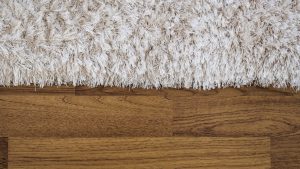Choosing Carpet: Carpet Fibers and Carpet Pad Carpet Fiber Types
The selection of fiber affects the end use performance of carpet. Carpet fibers come in some basic types, which are as follow:
Nylon Fiber
Nylon is usually used in carpet. The features of this type of carpet fiber include the aptitude to produce a range of color schemes, excellent resiliency, luxurious soft “hand”, durability, texture retention and abrasion resistance. It also features good resistance to soils and stains. Nylon carpet fiber is suitable for any traffic types. Solution dyed nylon fiber improves stain cleanability and offers exceptional color fastness. 
Olefin or Polypropylene Fiber
Olefin features natural and permanent water-based resistance, static electricity resistance and colorfastness. Olefin carpet fiber is moisture resistant, making it the main type of fiber used in indoor/outdoor carpet.
Polyester Fiber
This type fiber features natural and permanent resistance to stains, fade resistance, abrasion resistance, cleanability and ability to provide bright colors.
Triexta Fiber
Triexta carpet fiber features luxurious soft “hand”, bright color, excellent colorfastness, and natural and long-term stain resistance. Its features also include fading resistance, durability, cleanability, resiliency and texture retention.
Wool Fiber
Wool fiber is a natural type of carpet fiber that is popular for its performance and luxury. It features soft “hand”, color variety, high bulk and natural flame retardant qualities.
How to choose a right carpet pad?
A resilient and firm carpet pad is important to create a great foundation for the carpet, increasing its life and comfort by performing as an absorber to shock when someone walks over the carpet. The carpet pad, or cushion, helps buffer noise and offers better insulation, which makes a room warmer and quieter.
When choosing carpet pad, check the requirements of the carpet manufacturer for density and thickness. Improper choice of carpet pad can harmfully affect the look of carpet, can cause buckling and wrinkling, cause carpet seam separation ad cause a carpet structure breakdown. In addition, improper cushion choice may void the warranties of the carpet manufacturer.
For most residential applications, select carpet padding less than 7/16″ thick and more than 1/4″ with 6 lbs. density per cubic feet. If you choose a low profile or a Berber carpet, select a pad less than 3/8″ thick with 8-lb density.
Carpet pad is created mainly from polyurethane foam, rubber or fiber and is offered in a range of constructions and styles to suit your necessities. The cushion thickness and type you need differs according to patterns and traffic levels. For instance, dens, lounge areas, bedrooms and other areas with moderate or light traffic can use softer and thicker cushion, while family rooms, living rooms, stairs, hallways and other areas with heavy traffic require firmer and thinner carpet pad.
Residential cut pile, high-level loop, or cut-loop carpet calls for a firm and resilient carpet pad with a 7/16″ thickness and more than 1/4″ with 6 lbs. per cubic feet density. Cushion types may be a range of polyurethane foams, including rebond, rubber, or fiber.
Cut pile or thinner loop or Berber carpet is created with wide and large loops, and has been found that it requires a stable and low-flexing cushion. A softer and thicker cushion isn’t applicable. The thickness of cushion must not exceed 3/8″ for these products.



